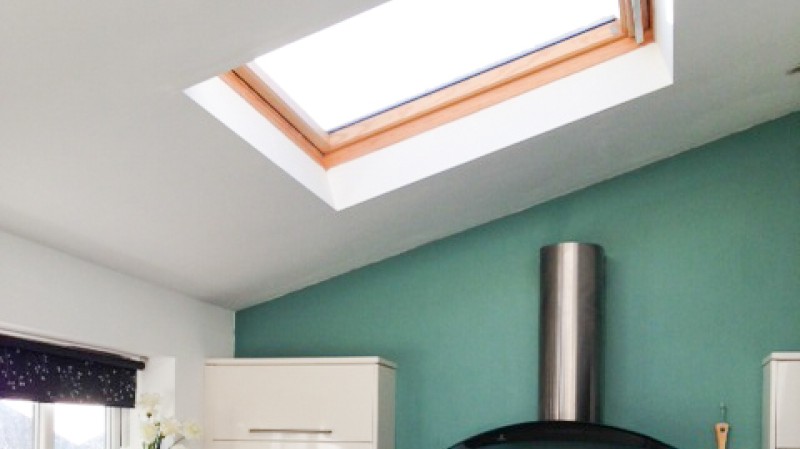You are here: Roof lanterns vs skylights
When you want to bring extra light into your home rooflights offer a solution – but which is the best option?
Rooflights can transform a dark room into an airy and light-filled space. Single-storey kitchen extensions, loft conversions and gloomy corridors can all be brightened up by adding a rooflight or two. Whether you opt for a traditional roof lantern, or a contemporary flat skylight can make a big difference to the look and feel of a room. Here we delve into the detail of these two different designs.

Aesthetics & shape
Ideal for flat roof single-storey extensions, roof lanterns project from the roof like a miniature conservatory. They add both light and height to the room below, making it look and feels bigger. A popular feature in Georgian, Victorian and Edwardian homes, when orangeries became fashionable, there are conservation style options for period properties as well as slim-line contemporary styling. Roof lanterns come in a range of shapes, including pyramid, rectangular and octagonal.
Skylights (also known as rooflights to add to the confusion) lie almost flush with the roof, so are a more design neutral, minimalist feature. They are suitable for pitched and flat roofs, so more flexible. There are also many different sizes and styles, including walk-on. Skylights are perfect for boosting natural light when a vertical window is not possible, for example in loft conversions and stairwells.
Ventilation & views
Some roof lanterns have opening options to assist ventilation, though most are fixed features. A roof lantern can be vented to comply with Building regs, by adding trickle vents– small openings in a window that allow air to pass through.
Skylights offer more choice in terms of opening options, which is important if the room is poorly ventilated. The roof window can either be fixed, sliding or open by a centre-pivot or be top-hung. By installing two or more rooflights you can enjoy panoramic views. In a loft conversion, if the pitch of your roof extends to the floor, you can extend the skylight by installing an additional fixed window (vertical or sloping) to maximise daylight as well as your view of outdoors, sitting or standing.
Light
A roof lantern can be a stunning architectural feature and is often positioned above a kitchen, dining or living area, making it the heart of the home. The 3-D glazed structure captures light from different angles, so there is more low-level light during the morning and evening as well as bright top light. By comparison, a flat skylight lets the most direct sunlight in but less low-level light. If bringing maximum light into your home is top of your wish list, a roof lantern has the advantage.
Planning permission
The rules on permitted development (when you don’t require planning consent) state that any alteration must not project more than 150mm above the existing roof plane and be no higher than the highest part of the existing roof. A roof lantern, by definition, will need planning consent whereas in most cases a flat skylight.
If a roof lantern is installed when a new extension is being built, it will be part of the overall planning application. The rules on whether your project requires planning consent are quite complicated, so check with your local planning authority and/or architect. You can also look at the government Planning Portal for guidance. If the roof lantern is being retrofitted to an existing roof, it’s likely to need planning consent.
Planning permission is always required if your home is a listed building, in a conservation area, national park or area of outstanding natural beauty to preserve buildings and areas of special architectural or historical interest.
Building Regulations
If your rooflight is installed as part of a new extension, the roof will need to be strong enough to take its weight and be framed in a specific way. It’s advisable to consult a structural engineer who will do the calculations and draw up proposals which will be considered by the building control department of your local authority when it deals with the rest of the project.
When you retrofit a rooflight into an existing roof, it will need to be approved by a building control inspector. Installing a roof lantern usually involves cutting away one or more of the roof rafters or joints. It’s important the new opening is structurally sound and weatherproof to comply with Building Regulations. Weather-resistant flashing will need to be fitted around the edges to allow the water to drain away and avoid leaks.
Roof lanterns and skylighs also need to meet the current requirements for energy conservation or the amount of heat that can pass through the glazing and frame, which is measured as a U-value. The lower the u-value, the more efficient the insulation.
Glazing options
Because of the pitch of pyramid-shaped glass, rainwater should run off a roof lantern easily. Flat skylights, on the other hand, will need to be cleaned more regularly. If your rooflights are difficult to access, consider low maintenance glazing options that requires less frequent cleaning.
Spaces with roof lanterns and skylights risk being too hot in summer and too cold in winter – the greenhouse effect, especially if the room is south-facing. Choose energy efficient double or triple glazing for winter heat retention and low-g glass that lets through a low percentage of the solar heat. Overexposure to ultraviolet light can be dangerous. There are some clever solar control glazing treatments, that remove the UV but still allow the full quota of light.
Price
Roof lanterns tend to be slightly more expensive per square metre than skylights. So, if you are on a tight budget a skylight might be more affordable. Prices start from £4oo for a basic small uPVC roof lantern rising to £4,000 for a mid-sized aluminium one. At the budget end, a skylight can cost about £300-£600. As the size increases, so does the price tag. Choice of frames makes a difference, too. uPVC frames are cheaper than timber or aluminium. Extra features, such as electronic opening systems or solar control glass will add to the bill. A bespoke rooflight will be more expensive than a standard, off-the-shelf product. Don’t forget to factor in labour costs for fitting the rooflight.
Position
Whether you opt for a roof lantern or skylight, where you position it is a key decision. Depending on the direction the room is facing, you will get more concentrated brightness at different times of the day. Think about when you want most daylight in a particular room. Rooflights installed on east-facing flat roof kitchen extensions will provide maximum light and solar heat gain in the morning when your family eat breakfast. Whereas rooflights on north-facing roofs provide more constant, cool illumination.
Both roof lanterns and skylights have their own benefits and can make a great addition to your home. But it’s important to understand how they differ to make the right choice.
If you are looking to make some home improvements, you may find some of these services useful
Building Regulations
Find details of local experts who can help with Building Regulations
Builders
Find local help with a building project
Architectural Design Services
Find local Architectural Design experts
Structural Inspections
Find an expert to carry out a structural inspection
Building Surveys
I want a local surveyor to do a Building Survey for me
Choose which Architectural service you require
If you are not sure which service you require, check out the options available...


